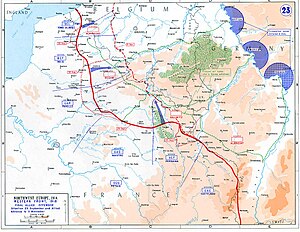Fifth Battle of Ypres
| 5th Battle of Ypres | |||||||
|---|---|---|---|---|---|---|---|
| Part of the Western Front of World War I | |||||||
 Map of the final Allied offensives on the Western Front, 1918 |
|||||||
|
|||||||
| Belligerents | |||||||
|
|
|||||||
| Commanders and leaders | |||||||
|
|
|
||||||
| Strength | |||||||
| 28 divisions | 16 divisions | ||||||
| Casualties and losses | |||||||
|
|
Unknown dead or wounded, 10,000 POW, 300 artillery pieces, 600 machine guns |
||||||
The Fifth Battle of Ypres, also called the Advance of Flanders and the Battle of the Peaks of Flanders (French: Bataille des Crêtes de Flandres) is an informal name used to identify a series of battles in northern France and southern Belgium from late September through October 1918.
After the German Spring Offensive of 1918 was stopped, German morale waned and the increasing numbers of American soldiers arriving on the Western Front gave the Allies a growing advantage over the German forces. To take advantage of this Marshal Ferdinand Foch developed a strategy which became known as the Grand Offensive in which attacks were made on the German lines over as wide a front as possible. Belgian, British and French forces around the Ypres Salient were to form the northern pincer of an offensive towards the Belgian city of Liège. The British Second Army had followed up some minor withdrawals and had fought the Action Outtersteene Ridge on 18 August, after which the front had become quiet, resulting in Allied troops in the area being well-rested by late September.
The Groupe d'Armées des Flandres (G.A.F.) attacked at 5:30 a.m. on 28 September, with 12 Belgian divisions, 10 British divisions of the Second Army and 6 French divisions of the Sixth Army under the command of King Albert I of Belgium with the French General Jean Degoutte as Chief of Staff. The British attacked without preliminary bombardment on a 4.5-mile (7.2 km) front up to the Ypres–Zonnebeke road, from where the Belgian army attacked on a line north to Dixmude. The Allied attacks quickly penetrated the German defences and advanced up to 6 miles (9.7 km). The German defence was conducted by fewer than five divisions which were swiftly driven back. Much of the ground west of Passchendaele which had been abandoned during the withdrawal of early 1918 was recaptured. Rain began to fall but by the evening the British had taken Kortewilde, Zandvoorde, Kruiseecke and Becelaere; Belgian troops had captured Zonnebeke, Poelcappelle, Schaap Baillie and Houthulst Forest. On the southern flank, minor operations by three British divisions advanced to St.Yves, Messines and the ridge from Wytschaete to Hollebeke. Messines, Terhand and Dadizeele fell on 29 September and by 30 September, despite the captured ground becoming another slough, all of the high ground around Ypres had been occupied by the Allies. By 1 October the left bank of the Lys had been captured up to Comines and the Belgians were beyond a line from Moorslede to Staden and Dixmude. The advance continued until 2 October, when German reinforcements arrived and the offensive outran its supplies. Due to the state of the ground, 15,000 rations were delivered by parachute, from 80 Belgian and British aircraft.
...
Wikipedia
